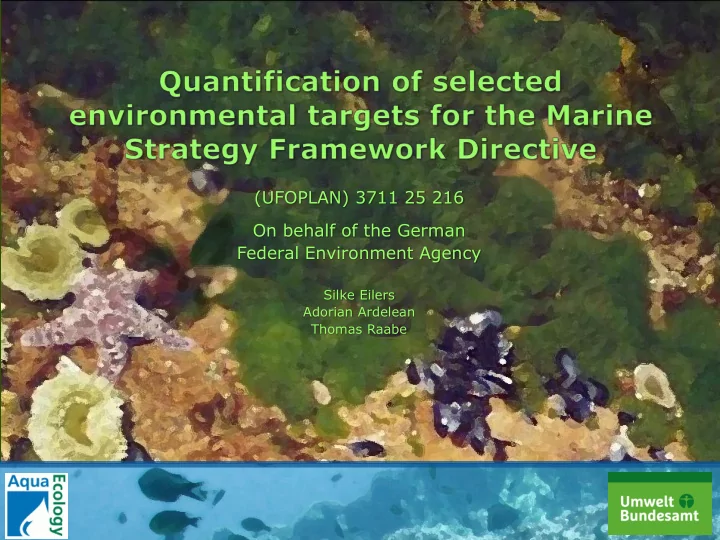

(UFOPLAN) 3711 25 216 On behalf of the German Federal Environment Agency Silke Eilers Adorian Ardelean Thomas Raabe
Content Introduction Overview Literature based Analysis and Assessment Tool – LiACAT New developments in LiACAT Quantification of anthropogenic impacts Application of model results for the BSII and for the quantification of environmental targets Examples
Assessing the status of different ecosystem components
The LiACAT tool Literature data input forms, which can be customised Spreadsheet form for getting a quick overview Special input option for relationships Possibility to filter information by setting topic specific tags Visualisation of relation- ships and cumulative effects with a Sankey diagram
New developments in LiACAT WebPlotDigitizer As a new module, the WebPlotDigitizer is implemented and can be used within LiACAT. With this module, raw data can easily be extracted from graphic presentations in the publications and be imported to LiACAT
New developments in LiACAT Geographical Toolkit Uploading of geographical data such as species distribution data can now be uploaded and be visualised on a map. Special features: interpolation, functions for simple calculations and mapping of monitoring stations
New developments in LiACAT New Sankey diagram The new Sankey diagram will allow to show literature information in a clear way for a chosen level of detail, while it will still be possible to access the detailed information by a very user-friendly zoom-in function
New developments in LiACAT Interaction effects An additional, new type of matrix is being implemented specifically focusing on the analysis of interaction effects
Quantification of anthropogenic impact based on literature analyses Physiological effect Biochemical effect Population effect Intensity of pressure Physiological effect Biochemical effect x % decrease of population size
Application of the method for the quantification of environmental targets Expample for a comparison of predicted change with environmental targets Predicted population “to restore populations to, or size for a pressure maintain them at, 80% or scenario for 6 years more of carrying capacity” based on present (ASCOBANS, 1997) monitoring data
Application of the method for the BSII Application of the method for selected ecosystem components Combination of the results from the expert questionnaires and other literature analyses by transferring the results into categorical data Ranking of the pressures Comparison of the results from different analyses Visualisation of the complex pathways and impact chains (input for the report?) Test of management options
Example seagrass meadows We extracted about 150 datasets from publications so far to quantify relationships including mainly effects related to seagrass meadows but also to blue mussels Input: Output : Pressure % change and scenario or corresponding monitoring data environmental status
Example blue mussels Cumulative index value between -1 and 1 In this example: -0.56
Recommend
More recommend